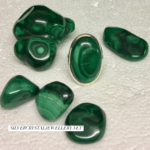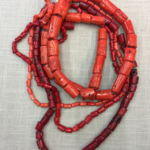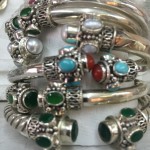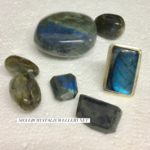The name Asscher has been attached to many of the diamond industry’s major moments. It’s a name associated with some of the largest diamonds in the world, a name that’s seen it’s share of dark times, and one responsible for a diamond cut that came to symbolize an era. It’s a name with more than one story to tell.
Like all such tales, the origins of the House of Asscher fall onto the shoulders of just one man, master cutter Joseph Isaac Asscher. In 1854 Asscher, already a known entity in the relatively small diamond industry, decided to start the I.J. Asscher Diamond company. That company bore the name of Asscher’s son, Isaac Joseph, and foreshadowed the close ties that the Asscher family would have with the diamond industry.
The founding of I.J. Asscher happened at less than fortuitous time. In the company’s first few years of operation, diamond mines around the world started to go dry. The decreasing number of active diamond mines pushed the diamond industry into a recession the likes of which it had never seen before. The Amsterdam diamond industry was largely decimated, and the Asscher’s watched as other cutting, cleaving, and polishing houses closed up shop. By 1870, a mere sixteen years after the founding of I.J. Asscher, the flow of uncut diamonds had shrunk to a mere 5000 carats for the year. At that rate, the Asscher’s were holding out for a miracle as much as they were holding onto their business.
Holding out proved to be a wise decision. The year 1870 saw the famed first South African diamond strike, an act that flooded Amsterdam with diamonds and saw the creation of De Beers by none other than Cecil Rhodes. With Isaac at the helm, the I.J. Asscher company jumped into action, helping Rhodes’ new company to host the original diamond sights and breathing new life back into the ailing Amsterdam diamond markets.
The sudden wealth of diamonds helped to move the I.J. Asscher Company towards becoming one of the most influential names in the Amsterdam diamond market. De Beers personally requested the Asscher house to cut what was, at the time, the largest diamond ever – the 995.2 carat Excelsior diamond. The titular Asscher, who had remained at the company’s helm into the early years of the twentieth century, passed away just months before the Excelsior diamond was delivered to his company.
With Isaac’s death, the duty of handling the Excelsior diamond fell onto the shoulders of his eldest son, Joseph Asscher. Joseph had made a name for himself as a diamond cleaver and innovator within the company and took that expertise to the cleaving of the nearly 1000 carat gem, successfully rendering several large pear-shaped, marquise, and round diamonds. In 1905, Joseph was tasked with cleaving an even larger diamond – the Cullinan, a stone weighing more than three times that of the Excelsior and who’s stones went on to become part of the Bright Crown Jewels.
The history of the Asscher house wasn’t to be made by large stones, though. No, that path actually predated the cleaving of Excelsior and relates to a patent filed by Joseph in December 1902. This patent was for a square cut diamond with chopped-off corners, a three-step crown, and a seven-step pavilion. The design, which presented a notably small table, allowed for a marked amount of reflected light, thus a sound measure of brilliance.
Over the early parts of the twentieth century, Joseph Asscher continued to refine what was quickly becoming known as the Asscher Cut Diamond. He reduced the steps in the crown to 2 or 3cuts, and the pavilion to a mere 3 or 4 steps. The modifications to the Asscher cut increased the overall brilliance of the stone.
As Joseph was modifying his own diamond cut, the rest of the world was being swept up into the Roaring Twenties. Art Deco became the art style of the day, daring angles were being set off with grand sweeping curves, and the dramatic cut of the Asscher diamond not only fit into this design aesthetic – it came to exemplify it.
In 1936, Joseph Asscher, together with his brother Abraham, decided to officially change the name of the family diamond business from that of their father to the Asscher Diamond Company. For the newly named company, things seemed on the way up. The dark clouds brewing in Germany, however, would soon argue otherwise.
Despite a declaration of neutrality, the Nazi war machine officially began the Battle of the Netherlands on May 10th, 1940. The Dutch army put up a hefty resistance and were able to stave off the invaders for five days. Those five days, which saw Rotterdam nearly destroyed by firebombing, were almost kind compared to the fate which stood before the Amsterdam diamond industry, the vast majority of which were Jewish.
The Asscher Company’s diamonds were quickly seized by the Nazis while those who worked there were shuttled away towards concentration camps. The concentration camps weren’t kind to the House of Asscher. Only two members – Abraham’s sons Joop and Louis – survived internment. Adding insult to injury, the patent which Joseph had filed protecting the Asscher Cut Diamond expired. By the end of World War II, the Asscher Diamond Company was in tatters.
The period following the war was one of tenuous reconstruction for the once powerful Asscher family. Luckily, the De Beers business was able to lend a hand, giving the Asschers with rough diamonds and access to the company’s diamond sights. With this help, the Asschers were able to gain some of the strength that they had before, returning to their status as a first rate diamond cutting company, but the diamond shine seemed to be missing.
The 1980s saw that luster returning. After more than a century in operation, the Asscher Diamond Company was the recipient of the last Royal title handed out by Queen Juliana of the Netherlands before her abdication of the throne. The title brought about the third and final name change to the house of Asscher, recreating the company as the Royal Asscher.
That title was just the start of the Asscher return to glory. Just as the company has gone through three name changes, the Asscher invented diamond cut was slowly starting in on its third innovation. In 2001, nearly a hundred years since the patenting of the initial Asscher cut diamond, the Royal Asscher Diamond company released the Royal Asscher cut diamond. The new cut is a scientifically guided improvement on Joseph Asscher’s initial design, increasing the diamond to a stunning 74 facets. For the Asscher family, which still remains a family affair, the new cut seems to represent both a new chapter in the family’s history and an homage to days of past.
Jill Renee- This article is provided by DanforthDiamond.com a leading authority on wedding rings, engagement rings and fine jewelry. Danforth Diamond provides wisdom and advice to help you choose the right ring at the right price. Visit DanforthDiamond.com or call 877.404.RING



